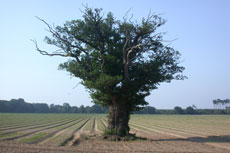 |
| This ancient oak has been ploughed within an inch of it’s life as a result of the intensive farming of this sandy east Suffolk field. Photograph Andrew Cowan 2003 |
Protecting our ancestors legacy for the generations of the future.
Words:Andrew Cowan
Photography:Andrew Cowan
Published: essentialARB issue 12 Summer 2004
Internationally the UK has become famous for it’s wealth of ancient and veteran trees, described by literary greats like Hardy, Keats and Ruskin; illustrated by Constable, Millais and Strutt; while more recently others have become silent stars of feature films like Robin Hood Prince of Thieves. As a result some are now tourist attractions, described in books that provide details of their history. However, many more remain forgotten, overlooked and neglected, by a nation that fails to appreciate their true value.
Our time on this earth is short, on average a mere ‘three score years and ten’, yet the effect of our actions and decisions will be experienced by the generations born decades or centuries after our death. This is never more true, than of people who work with trees. Whether they are responsible for planting, pruning, or supervising their protection, their actions must be guided by great foresight.
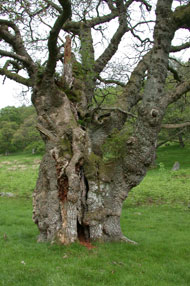 |
| The decaying heart of ancient trees provides an irreplaceable habitat for a diversity of our most endangered and rare flora and fauna. Photograph Andrew Cowan 2002
|
They say an oak tree grows for 300 years, rests for 300 years and then spends some 300 years gracefully expiring. But there is also life after death, in the habitat created by the decaying wood of the trunk and main branches, which may last a further 300 year or more. The long life of such trees means that organisms associated with them grow reliant on a continuity of habitat that develops and matures over centuries.
Whether you work at the sharp end as an arboricultural contractor, or on behalf of the council as a tree officer, a tree warden or simply have an interest in trees, you will be aware that since the late 1940’s there has been some legal protection for trees. Since its inception the legislation, included within the Town and Country Planning Act 19471 , has enabled local planning authorities (LPA’s) to protect trees and woodlands in the interest of amenity by the making of tree preservation orders (TPO’s).
Trees are also accorded some limited protection through their inclusion within Conservation Areas, which are covered by Part II of the Planning (listed Buildings and Conservation Areas) Act 1990. Conservation areas are areas of special architectural or historical interest, the character or appearance of which it is desirable to preserve or enhance. However, the protection for trees only guards against wilful damage or destruction and is ultimately reliant on the making of a TPO to fully protect trees considered worthy of retention.
It has been estimated that the UK has approximately 80 per cent of northern Europe’s ancient trees. The Woodland Trust, Ancient Tree Forum and the Tree Register have developed a provisional list of significant sites for internationally important old growth communities in lowland Britain and Ireland. This list currently comprises only approximately 50 sites that have more than 100 ancient trees on each. Very few of the sites with less than 100 ancient trees have adequate protection, while many more sites and trees are yet to be ‘discovered’. (Woodland Trust News Release April 2004)
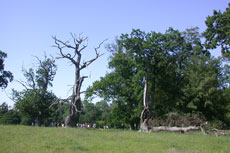 |
| This photograph of the historic park landscape of an old estate in Suffolk, illustrates well the integral part dead trees play in the diversity of this cultural scene, and one that has been appreciated by our famous landscape architects of years gone by. “The man of science and of taste will.... discover the beauties of the trees which others would condemn for its decay” Humphry Repton “Observations on the Theory and Practice of Landscape Gardening” 1803 |
In the UK we take for granted the lines of old trees which grow in the hedges around our countryside, the majestic trees of our parks and gardens and the historic specimens that stand on the village greens, we pass them by without a second thought. But these trees are in fact the UK’s national treasure especially in comparison to other parts of Europe, which has been aptly described by Oliver Rackham (2001) as “a continent of youngish trees, like a human population with compulsory euthanasia at age thirty; one can go from Boulogne to Athens without seeing a tree more than two hundred years old”.
Despite an indisputable acknowledgement of the intrinsic historical, cultural and ecological value of some trees many of our rarest most vulnerable specimens remain exposed with no means of effective protection. We take them for granted, not appreciating their worth until threatened and then it is often too late. Thomas Pakenham in his book ‘Meetings with Remarkable Trees’ (1996) lamented that “most depressing was the experience of finding 1,000- year-old trees, once famous and well cared for, now left to their fate, like the yews at Lorton and Borrowdale in Cumbria, whose bark is being stripped by local sheep.” Traditionally in many European countries old trees have been cut down, when they have reached a certain age or size, or when it is considered that they area at the end of their useful life expectancy.
“Ancient trees are precious. There is little else on earth that plays host to such a rich community of life within a single living organism”
Sir David Attenborough (2002)
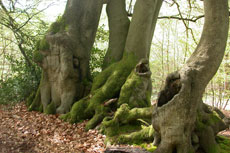 |
| These veteran beeches are part of an old boundary system lined by 20-25 similar trees, that may once have been in a hedge, but are now lost in the middle of a neglected wood. Photograph Andrew Cowan 2004. |
Existing Acts, Regulations and Designations, which could protect ancient trees
Tree Preservation Orders:
You would think that Tree Preservation Orders (TPO’s) and to a lesser extent Conservation Areas, would be the most specific form of legal protection which could be used to protect ancient trees. As all trees are a ‘material consideration’ in the planning system you would think that historic and venerable old trees would be specially recognised.
However, current government policy regarding which trees qualify is now seen by many to be too restrictive and limited by the interpretation of the term ‘Amenity’, which is generally transposed to mean visual amenity. The guidance provided by the DETR within the ‘Blue Book’2 says that the LPA needs to show that; a reasonable degree of public benefit would accrue before a TPO is made or confirmed. This is primarily based on the visual impact a tree has on it’s immediate area, that is, whether the tree or part of the tree can be seen from a public space like a road, footpath, park or several private residences.
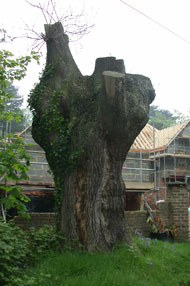 |
| This old pollard in Farnborough, Kent, has lost the fight to survive some overzealous pruning. The tree is thought to be over 400 years old, an age that the new building behind is unlikely to see. It would in fact be interesting to see, if the oak survived the threat of being cut down, whether the dead trunk lasted longer that the house. Photograph Andrew Cowan 2004 |
The public benefit could be present at the time of making the order or it could be foreseeable if the tree(s) concerned are young and have not reached their mature size. However, the guidance fails to take account of trees, that due to their great age, are ‘growing down’ by retrenching and relocating growth resources in the lower canopy and main branch frame. As a result our oldest, and arguably most valuable trees may be left unprotected, just because they do not have the physical stature to be seen over the roof of a two story house.
The TPO guidance does recognise the public benefits could include a tree’s intrinsic beauty, it’s contribution to the landscape or where it screens an eyesore like a development, all of which could be current or future. So while one man’s beauty maybe another’s ugliness we need to raise awareness of the craggy, individualist character and beauty of trees. As Humphry Repton the great landscape designer once said “The man of taste and of science will …discover the beauties in a tree that others would condemn for it’s decay….”
Value may also be enhanced by a tree’s rarity or an individual tree’s value may be increased where it forms part of a group. With this in mind it is worth remembering that although the UK is blessed with ancient trees they are still uncommon. As they are very rare in northern Europe we in the UK have a special responsibility to retain them.
The ‘Blue Book’ also suggests that there are other factors, which could be considered, that on their own may not be sufficient to warrant the making of a TPO. For example, wildlife value may be one such factor, but at present it is not enough in its own right and nor is a tree’s historic value sufficient to carry the day on it’s own. Yet this would not be the case with a Scheduled Ancient Monument.
The guidance provided by the Secretary of State recommends that “trees/woodland should be protected if their loss would be a significant impact on the local environment and its enjoyment by the public”. However, although this statement appears to broaden the spectrum of trees that could be protected, the recommendation that “it would be inappropriate to make a TPO in respect of a tree which is dead, dying or dangerous”, counteracts in a very negative way. The first statement appears to open the door for including ancient and veteran trees that are important to the local environment and enjoyed by the public, but the latter exclusions firmly slam the door in the face of effective protection.
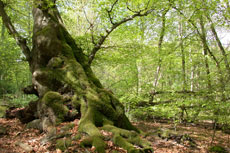 |
| What remains of this old veteran beech still marks a historic boundary, now lost in the woods of Limpsfield Chart in Surrey. Photograph Andrew Cowan 2004 |
Other problems exist with area or group orders because they do not protect the historic feature, for instance where they may be applied to parkland or wood pasture. Unlike the Historic Parks and Gardens Register a TPO does not ensure that the features and qualities which make the tree important are safeguarded during management or development. Again although wildlife value can be considered as one of the factors for making an order, the removal of dead, dying and dangerous branches or entire trees, does not require consent. This means that one of the single most important habitats can be stripped from trees, despite it’s value within the populations of trees under protection.
Another less appreciated drawback of the use of TPO’s to protect trees is that there is no mechanism to identify or provide incentives to manage positively those trees/groups of trees, which are of more than local importance. Ancient trees are internationally important from a historical point of view, while the unique conditions found in veteran trees provides irreplaceable habitats for rare and endangered flora and fauna.
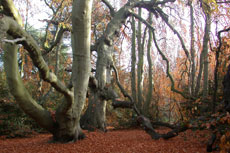 |
| Described by Thomas Pakenham as the Multiplying Mourners of Knap Hill, this magnificent weeping beech tree has spread its vast dome of pendulous branches, that have rooted, grown to trees who’s branches have rooted and grown again, so that now the same tree (genetically at least) covers half an acre of ground. Photograph Andrew Cowan 2003 |
Hedgerow Regulations 1997:
According to the government, hedgerows represent some of the most important habitats in lowland Britain (HMSO 1995) and in England and Wales the Hedgerow Regulations 1997 are intended to protect important countryside hedges from destruction or damage. The legislation is very complicated and has been the subject of much criticism. The regulations are presently under government review but no announcement has been made about any time-scale for change.
The regulations clearly identify the important habitats and historic archaeological features included within hedgerows, and the need to protect them as part of a connective landscape, and include trees contained within them. However, the regulations fall short of recognising the importance of historic trees in the criteria of protection, and the controls only apply to removal or destruction of a ‘hedgerow’. Roots of trees and damaging acts less than destruction are not controlled. The regulations do not ensure that the features and qualities, which make the hedgerow important are safeguarded during management.
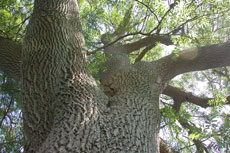 |
| The branches of this ancient oak in Suffolk reach for the morning sun like the tentacles of a terrestrial octopus. Photograph Andrew Cowan 2003 |
Many of our most impressive ancient trees exist as boundary markers at cross roads or in lines within historic hedges. Many more hedgerow trees have survived to become ancient due to their history of management, where they have been pollarded to provide fodder for farm animals. However, their local value has been lost in our modern age of intensive farming techniques, and now their roots fall victim to the plough, which follows the line of the hedge.
Habitat designations:
Landscape designations, used to preserve areas of habitat, like SACs3, SPAs4, NNRs5 SSSIs6, can provide some additional protection for trees. However, these are very specialised designations and are often only applicable to the top sites for ancient trees. They are also usually based on the species richness of a site and not the trees themselves, which provide the habitat for the important species! So it is the individually rare or endangers species that are protected and not the tree. This leaves many sites, which contain important populations of ancient and veteran trees without any form of designation and so they have no effective protection.
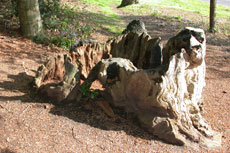 |
| The burnt out stump of an old oak pollard on Wickham Common in Kent, now the mere shadow of what used to be, but still a thought provoking reminder of our living heritage. Fossilised remains of tree stumps have been saved as treasures by proud archaeologists, but the teenagers still see just fire wood. Photograph Andrew Cowan 2004
|
However, a designated site is a material consideration in the planning system, and this in itself can provide some protection from the pressures of development. Unfortunately, designation does not prevent the trees themselves being left exposed to unsympathetic management or neglect, where the management plan to maintain the status of the designated site, does not take them into consideration. Unlike other parts of Europe a single tree is not considered a ‘habitat’ and cannot be individually designated to raise its profile in the planning system.
Ancient Woodlands or Sites of Nature Conservation Importance are another habitat designation that may be a material consideration in the planning system but can only direct planning authority to take account of the value of such sites. The Ancient Woodland Inventories rarely include wood pastures and parkland, nor do they include woods under 2ha, and some very significant ancient woods were missed on the original survey.
Planning Act 1990:
Local planning authorities can provide additional protection for trees generally by conditions attached to a planning permission, but this is time-limited protection, and often restricted to the duration of development. This leaves the trees exposed to the pressures of the new land use and is a form of protection only operative where planning permission is required.
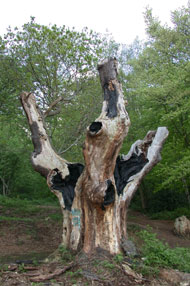 |
| A grand old pollard on Wickham Common, Kent, managed by the Corporation of London, clings to life by a thread. At the mercy of the local youth, who appear to have no appreciation or respect for the tree which has lived a life that they can barely comprehend. Photograph Andrew Cowan 2004
|
Register of Historic Parks and Gardens:
Since the 1980s, there has been a national record of historic parks and gardens. This record, known as the Register of Parks and Gardens of special historic interest in England and now containing nearly 1450 sites, was established, and is maintained by, English Heritage. The main purpose of this register is to help ensure that features and qualities of national importance are safeguarded during ongoing management or if any change is being considered which could affect them.
English Heritage registers only those sites that it considers to be of special historic interest. As a guide to the level of historic interest required to make a site ‘special’ nine criteria have been drawn up against which assessment and decisions whether to register a site are made. The criteria are based on the assumption that the older the surviving features of a site, the rarer that type of site is likely to be, although other factors are considered.
However, the main emphasis is on the quality of the designed landscape and on many sites ancient trees are not recognised as part of this landscape. Other sites do not fit the criteria even though the trees may form the main historic feature, and are therefore not included in the register. This is often despite the fact that the historic trees on the site may predate the designed landscape by centuries, and the original layout plans would have been created around the trees, possibly making them the focal points.
Where the register of historic parks and gardens does provides some limited protection of ancient and veteran trees, they are of specific historic interest. The inclusion within the register is a material consideration in the planning system, however there are no statutory controls or enforcement powers. The limited protection afforded to trees is as a by-product of the conservation regime, which is primarily directed towards protection of man-made designed structures and layouts.
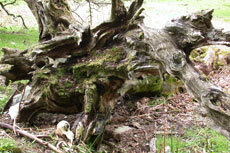 |
| Even after an ancient tree has long given up it’s fight for life, and the standing stems can no longer sustain an upright position, the upturned roots and gnarled trunk can support a diversity of organisms for many decades before finally decaying into soil. Photograph Andrew Cowan 2002
|
“The indifference towards old trees makes a mockery of our supposed new respect for the environment. Consider the raw facts. The giants of our native species – oak, ash and beech – are the biggest living things on these islands: heavier than any land animal, taller than most buildings, older than many ancient monuments. If a big tree was not a living organism it would still be a remarkable object. A big oak or beech can weigh 30 tons, cover 2,000 square yards, include ten miles of twigs and branches. Each year the tree pumps several tons of water about 100 feet into the air, produces a new crop of 100,000 leaves and covers half an acre of trunk and branches with a new pelt of bark. Yet the tree is alive. There is no mass production: every tree, sexually conceived, is built to a different design – as we see at first glance.”
Thomas Pakenham – Meetings with Remarkable Trees (1996)
Preserving Our Ancient and Veteran Tree Heritage
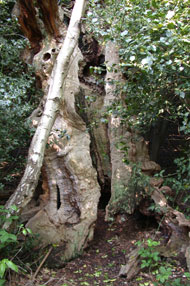 |
| This ancient natural sculpture, in its younger years, was painted by the artist Millais in 1853, in his portrait of The Proscribed Royalist 1651, which is now owned by Andrew Lloyd Webber. Photograph Andrew Cowan 2004
|
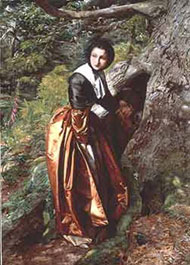 |
| Pre-Raphaelite & Other Masters: the Andrew Lloyd Webber Collection. Sir John Everett Millais, The Proscribed Royalist 1651, 1853. Oil on canvas framed with arched top 102.8 x 73.6 cm © 2003 Collection Lord Lloyd-Webber |
There are many who would like to see the SSSI guidelines amended to allow the inclusion of ancient and veteran trees in their own right. However others would say that this places too much emphasis on their scientific interest, while failing to recognise their cultural or ‘heritage’ values. In other European countries like Sweden, trees are preserved as monuments in much the same way as we preserve buildings of architectural or historical merit, or archaeological sites. In Germany, where similar protection is in place ancient trees are labelled and marked on tourist maps.
It must seem baffling to our continental counterparts that we lag so far behind and seam oblivious to the worth of such trees. A German forester Hugo Conwentz, in the early 20th century devised the concept of Naturdenkmal (denkmal meaning monument) believing that trees were natural monuments of as much inspirational and contemplative worth as great works of art or historic buildings. Yet in the UK, often described as a stronghold of ancient trees, we are only just beginning to recognise their value. Thomas Pakenham wrote in ‘Meetings with Remarkable Trees’ (1996) our “indifference towards old trees makes a mockery of our supposed new respect for the environment.”
The Tree Council, the umbrella organisation for those with an interest in trees, has for some years been campaigning with partners for greater protection for historic trees. Since their magazine ‘Tree News’ was first published, barely an edition goes by without the issue being promoted. In the spring 2002 Caroline Davies (Chairwoman of the Tree Council) wrote “Unless and until we address the fundamental undervaluing of this unique part of our historic, cultural and ecological heritage, and provide the appropriate resources to look after it, it will continue to be inexorably and irreversibly diminished.”
On Thursday 29 April 2004, the Woodland Trust and the Ancient Tree Forum, publicly launched their own campaign at Windsor Great Park, issuing a series of challenges to governments, conservation and heritage organisations and individuals to help secure a future for our ancient trees. The event was attended by nearly 100 people from local authority officers, conservation trusts and government bodies. Actress Prunella Scales spoke of her support for the initiative, while David Kidney MP provided political backing, suggesting reform of the TPO system to include additional protection for ancient and veteran trees.
David Kidney MP, who pledges his support for the campaign, currently sits on the Modernisation Committee, and is member of the Rural Group of Labour MP’s and all-party groups (APG’s) on Children, Conservation and Housing. He is also chair of the APG on Conservation and Wildlife, which was formed by a merging of the APG on Conservation and the APG on Wildlife Protection.
In a press release issued on 29th April the Woodland Trust and the Ancient Tree Forum call for the introduction of new policies to safeguard ancient trees and the prevention of further loss through better protective legislation. Jill Butler, the Woodland Trust’s ancient tree specialist, explains: “We need to find ways to extend and buffer important populations of ancient trees as well as improve financial support to encourage better care. We also need people’s skills and knowledge to be developed so that the trees can be properly looked after and the ancient trees of tomorrow are nurtured as well.”
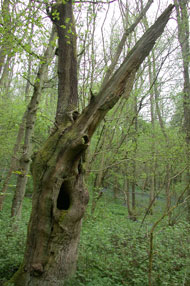 |
| This veteran oak, may not appear of any great note, for it’s size or age, but it is certainly the oldest tree in the wood, and represents some very valuable habitat. However, this venerable tree is at the mercy of the woodland management plan, which recommends the removal of dead dyeing and dangerous trees, that are not included within the TPO that cover the woodland. Photograph Andrew Cowan 2004
|
The importance of mapping our ancient and veteran trees was emphasised as a priority, because surprisingly we still have very little understanding or knowledge about the true nature of the resource we are trying to protect. Ted Green of the Ancient Tree Forum says: “A comprehensive map of ancient trees would help us to monitor threats and to put resources where they are most needed. An inventory would help us to raise awareness of the most important historic landscapes for trees. The conservation and protection of ancient trees is, for me, our one single, biggest obligation to European biodiversity.”
A great deal of work has been undertaken by the Tree Register, who maintain an expanding database of notable, ancient and rare trees growing in the British Isles. The register has a regularly updated on line list of over 3,000 trees, and they invite you to make your own contributions to this by completing a form on the web site. The Tree Register is now working in partnership with The Woodland Trust and Ancient Tree Forum to develop a living UK wide database of ancient trees.
The Woodland Trust and Ancient Tree Forum have produced a promotional publication called ‘Ancient Trees in the UK – Securing Their Future’ which asks people to take action to stop further losses of ancient trees and ensure they are properly recognised for their historic and biodiversity value. They stress that “if adequate steps are not taken in the next decade to find sustainable solutions to safeguard ancient trees and ensure there are new generations to replace natural loss, we will have failed in our stewardship.”
The publication challenges governments and organisations to make changes to the current legislation to include protection for ancient and veteran trees, and asks local communities to assist with the recording of trees, to increase our knowledge of their location and condition. Everyone can do something, even if it is just logging onto the Ancient Tree Forum web site, and registering an interest in ancient and veteran trees. If you feel like being a bit proactive, make sure your local trees are listed on the Tree Register site.
There is an old Indian saying that summarises our obligations quite well: “we do not inherit this earth from our ancestors – we borrow it from our children”, and in the case of trees we could be talking of our children’s, children’s children. What will be your arboricultural Legacy?
“Ancient trees of the future need to be provided for – especially the critical stage when a middle-aged tree starts to be called ‘decrepit’ or ‘unsafe’ and is liable to be removed before it has a chance to become ancient.” Oliver Rackham - Ancient Woodlands (2003).
Acknowledgements and Contact Details:
Download the Woodland Trust and Ancient Tree Forum campaign leaflet here
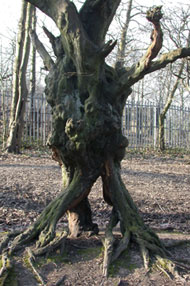 |
| Looking at the almost animated stride of this old hornbeam it does not take much imagination to drift into the world of JRR Talkien and the ents that guard over the woodlands of middle earth. Photograph Andrew Cowan 2003 |
The Woodland Trust and Ancient Tree Forum call on the European Union to:
• Allow The Natura 2000 designation to be extended to include sites with ancient trees as already happens in Scandinavia.
• Review the species associated with ancient trees and schedule the most threatened under the EU Habitats Directive.
• Make ancient trees a European cultural sustainability indicator.
• Encourage landscapes with ancient trees such as wood pastures or ancient hedgerows to be included in national, regional and community cultural strategies.
‘Ancient Trees in the UK – Securing Their Future’
The Woodland Trust and Ancient Tree Forum call on all UK national, regional and local government bodies, conservation and heritage organisations to:
• Create a new designation of ‘historic tree’ to help protect them from development pressures.
• Make changes to Tree Preservation Order legislation so that dying and dead ancient trees are eligible for protection.
• Make sure that ancient trees are identified and conserved throughout the UK Biodiversity Action Plan.
• Recognise important landscapes with concentrations of ancient trees, through effective historic and conservation designations.
• Extend important sites by the creation of wood pasture with young, open grown, trees that will be the ancient trees of the future.
• Buffer important sites from surrounding intensive land uses.
‘Ancient Trees in the UK – Securing Their Future’
The Woodland Trust and Ancient Tree Forum ask every city, town and village to:
• Rally their communities to help us compile the national inventory of ancient trees.
• Take action to protect ancient trees when development and other pressures threaten them.
‘Ancient Trees in the UK – Securing Their Future’
The Woodland Trust and Ancient Tree Forum call on policy makers, national and local government bodies to:
• Invest in new training, skills and information services to manage ancient trees and sites with concentrations of ancient trees.
• Strengthen agriculture, arboriculture and forestry policies and incentives so that best practice in managing ancient trees, wood pasture and parkland is positively encouraged.
• Create a series of large scale restoration projects around important concentrations of ancient trees demonstrating best practice.
• Provide financial support to landowners for specialist arboricultural work.
‘Ancient Trees in the UK – Securing Their Future |